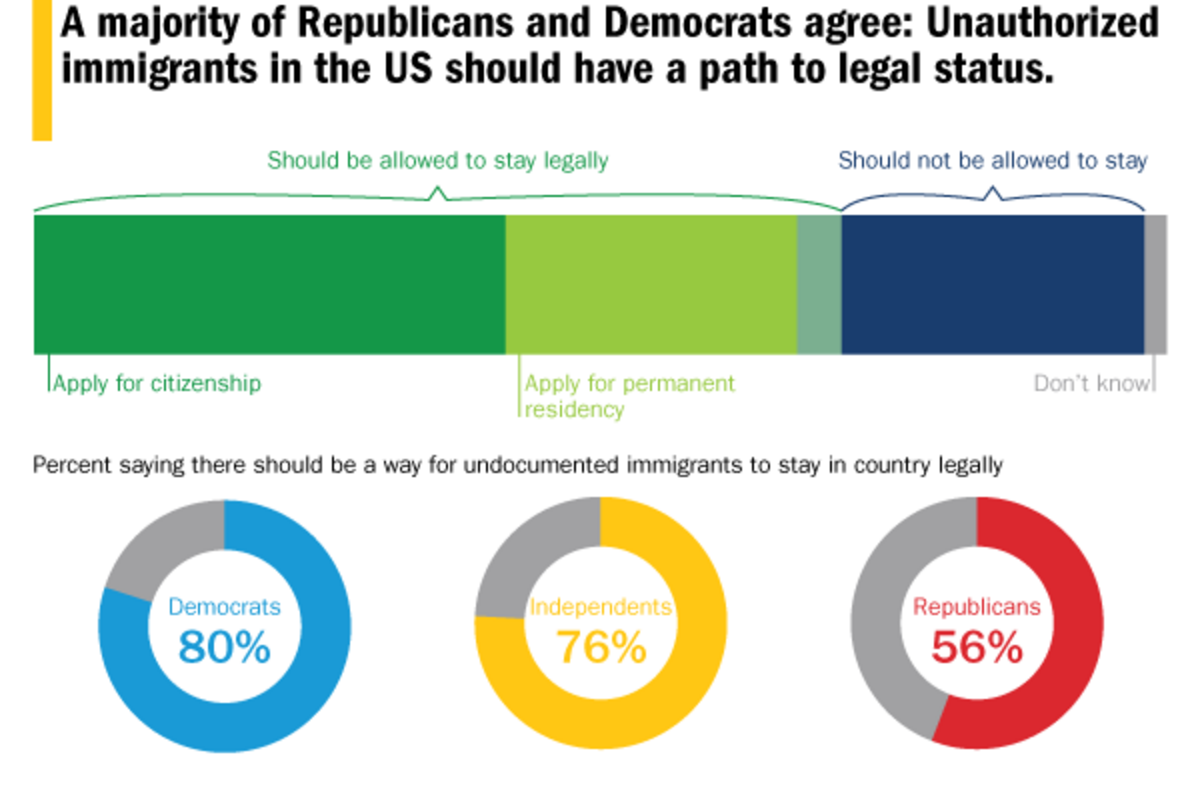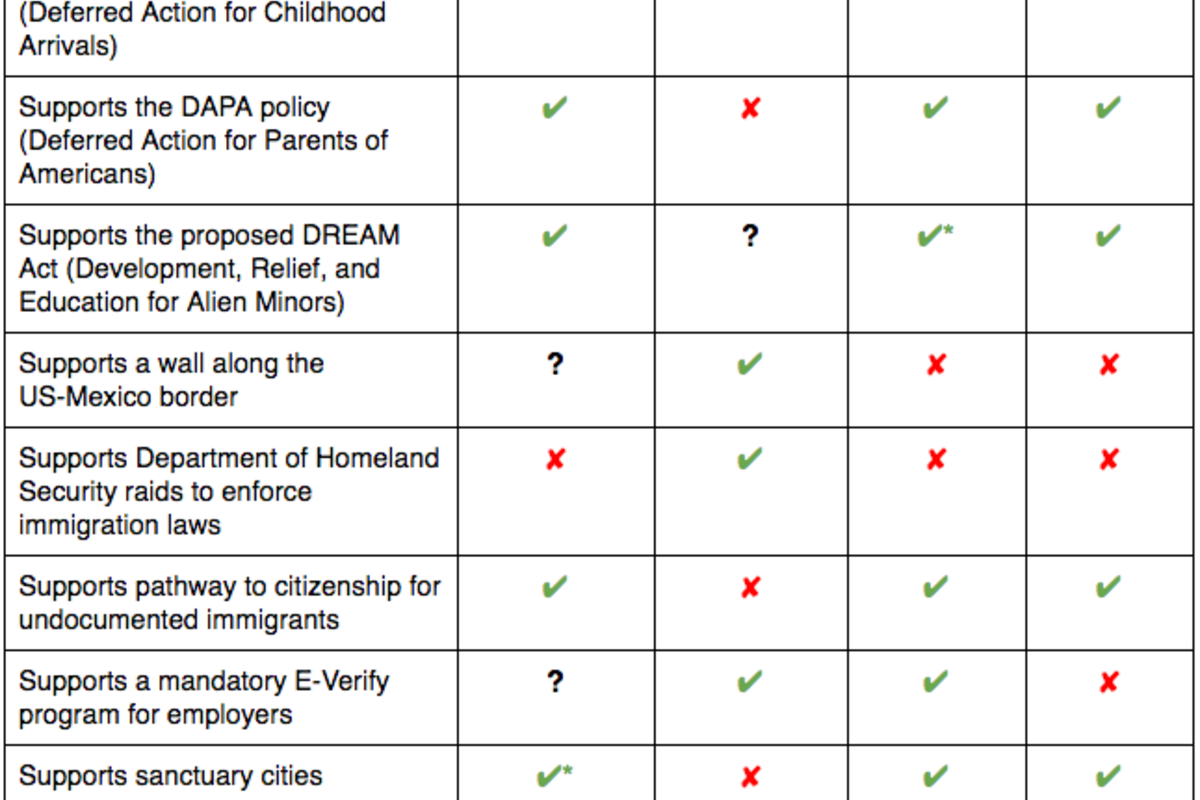The Politics of US series: Illegal immigration
Loading...
Follow us on Twitter @CSM_politics. Review the previous six installments, from guns to climate change, here.
In this week's edition:
- Cover story: Trump's border wall
- By the numbers: See which US president deported the most unauthorized immigrants
- The candidates: How Clinton and Trump differ on deportation raids, sanctuary cities, and more
- Profile: Behind the gavel of America's busiest judge
- Engage: Is the term 'illegals' derogatory or factual?
- Quizzes: Could you pass a US citizenship test?
- Our picks: "The Economic Case for Welcoming Immigrant Entrepreneurs" – and more
• • •
Trump's border wall: Would it work?
By Warren Richey, Staff writer
It is about a quarter-mile hike to reach the top of a ridge west of the fence. There, among the cactuses and the mesquite, lie several small clearings where it appears people have been sleeping. Discarded food cans litter the area, and a tangle of wire runs through the middle of it.
Welcome to the other US-Mexican border – the one without a barrier.
The border here looks easy enough for anyone to cross. Donald Trump wants to change that. To address the problem, the Republican presidential candidate makes a bold pledge. “We will build a great wall along the southern border,” he says. “And Mexico will pay for the wall.”
As if on cue, the crowds at his rallies respond with a now familiar mantra: “Build that wall.... Build that wall.... Build that wall....”
In a presidential election campaign unlike any in US history, Trump’s Wall looms large. At this point it is merely a proposal, yet the very idea of it has split the American public, offended Mexico, alienated American Latinos, and drawn a razor-sharp contrast between Mr. Trump and Democratic rival Hillary Clinton on the thorny issue of illegal immigration.
In a larger sense, Trump’s Wall is an ultimatum for the hemisphere and perhaps for the world – that it is time for the most powerful and richest country on earth to turn its generosity inward.
“There is only one core issue in the immigration debate, and that issue is the well-being of the American people,” Trump says.
“Under a Trump administration, it’s called America first.”
But beneath all the rhetoric on both sides of the issue, practical questions loom: Could a wall actually be built? How much would it cost? And, most important, would it really keep people out?
Read more
• • •
BY THE NUMBERS
• • •
THE CANDIDATES: Where they stand on immigration issues
We encourage you to contact the Monitor on Twitter @csm_politics or by email csmpolitics@csmonitor.com if you can improve our chart!
Sources: the Jill Stein campaign, the Gary Johnson campaign, the Hillary Clinton campaign website, the New York Times, CNN, Politifact, the Donald Trump campaign website, Donald Trump’s Twitter account, the Los Angeles Times, C-Span
• • •
PROFILE: Behind the gavel of America's busiest judge
By Tom A. Peter, Correspondent
LAS CRUCES, N.M. — Less than an hour into one of his regular morning dockets, federal district Judge Robert Brack has already sentenced 14 felons, or roughly one-sixth the number of people the average federal judge sentences in an entire year. The 15th defendant of the morning, Jamie Peña-Flores, stands before the judge shackled at the ankles, wrists, and waist.
“This is a tragic case,” says the man’s lawyer. Mr. Peña-Flores, a Mexican national, has spent most of his life in the United States working as a certified diesel mechanic and welder. He was most recently living in Wyoming, where he was making $28 per hour. His three children are American citizens and his wife has been diagnosed with cancer. Until this moment in court, the defendant had a clean criminal record, except for one incident of driving under the influence, for which he’d already served jail time.
Peña-Flores, however, entered the country illegally. For at least the second time in his life, authorities caught him trying to cross from Mexico, where he had recently returned for a visit, into the US, an infraction that can be prosecuted as a felony and is part of a burgeoning American strategy to reduce illegal immigration.
Read more
• • •
ENGAGE: Living Room Conversations and AllSides.com
- Are "illegals" criminals or just good people working within a broken system? Some see the term as derogatory, others as factual.
- Can I discuss illegal immigration with friends and family without a meltdown? Yes, follow this guide.
- How can we discuss illegal immigration in the classroom? Here is a specialized lesson plan.
• • •
QUIZZES: Test your knowledge on US citizenship
1. Could you pass a US citizenship test?
In order to become a US citizen, immigrants must pass the Naturalization Test. American citizenship bestows the right to vote, improves the likelihood of family members living in other countries to come and live in the US, gives eligibility for federal jobs, and can be a way to demonstrate loyalty to the US. Applicants must get 6 answers out of 10 in an oral exam to pass the test. According to US Citizenship and Immigration services, 92 percent of applicants pass this test.
2. How American are you? Take the alternative citizenship quiz.
To become a US citizen, immigrants must past a test that includes questions on government, history, and geography. But what really makes someone "American?" Here are 23 questions on everything from movies and music to fiction and food, with a little US history thrown in too.
3. How much do you know about literature by immigrants? Take our quiz.
How much do you know about literature by and about immigrants, old and new? Test your melting pot, tossed salad, multi-culti, all-American literary knowledge here … from A to Z.
• • •
OUR PICKS: Recommended reading and viewing
1. "A Little Reality on Immigration," by David Brooks, The New York Times
Donald Trump brings Republican crowds to their feet by bashing the supposed criminal hordes sneaking up from Mexico. The problem with this new orthodoxy is that it is ... based on a view of immigration that may have reflected 1980s realities, but that has little to do with reality today. The number of illegal immigrants flowing into this country is dropping, not rising....There are more Mexicans leaving the United States than coming in. According to the Pew Research Center, there was a net outflow of 140,000 from 2009 to 2014. If Trump builds his wall, he’ll lock more Mexican immigrants in than he’ll keep out.
2. “Immigrant America: The High Cost of Deporting Parents,” a VICE video
Here we are, they deport him, and we’re having to support his family that he was supporting. I don’t understand why they don’t check a little more what’s going on…. Because he was supporting his family, he had a good job, had a business, and there’s people here just living off us.
– Jeff Kesler, conservative and longtime friend of Ray Jesus, on the cost of his deportation to US taxpayers (estimated by VICE to be $102,710)
3. “US stuck with ex-cons it fails to deport,” Boston Globe interactive graphic (2012), with context from a related series
Immigration and Customs Enforcement, or ICE, routinely releases dangerous detainees to the streets of America without warning the public. Over the past four years, immigration officials have largely without notice freed more than 8,500 detainees convicted of murder, rape, and other crimes, according to ICE’s own statistics, mainly because their home countries would not take them back. (This graphic provides data sortable by city and type of crime.)
4. “The Economic Case for Welcoming Immigrant Entrepreneurs,” Kauffman Foundation (2015)
There’s something inherently entrepreneurial about leaving your home to start a new life in another country. Perhaps that is why immigrants tend to start businesses at a disproportionately higher rate than native-born Americans. From Alexander Graham Bell to Sergey Brin, immigrants have created some of America's most iconic companies. In fact, more than 40 percent of the Fortune 500 companies in 2010 were founded by an immigrant or the child of an immigrant. Yet, despite their vast economic contributions, US law provides no dedicated means for immigrant entrepreneurs to launch innovative companies in the United States.
5. “The New Case Against Immigration, Both Legal and Illegal,” book by Mark Krikorian (2012)
This is not a pessimistic or declinist argument. The problem is not that America has become decadent and weak and is thus unable to take full advantage of the blessings of mass immigration as it once did. Rather, a policy that served America’s interests during our national adolescence no longer serves those interests now, during our national maturity.








